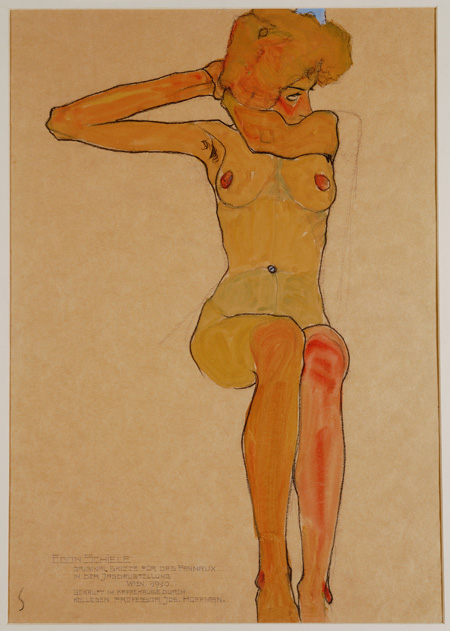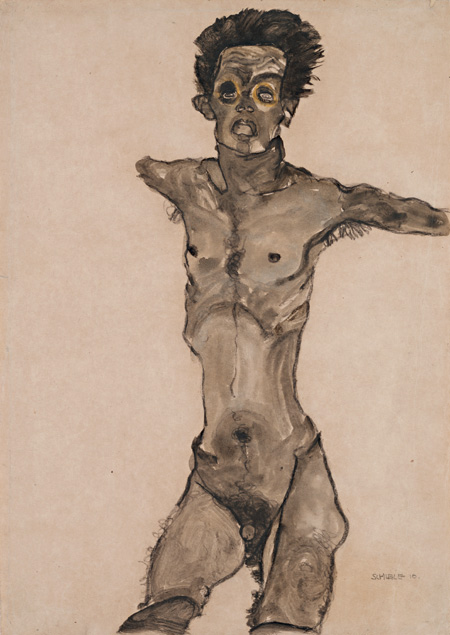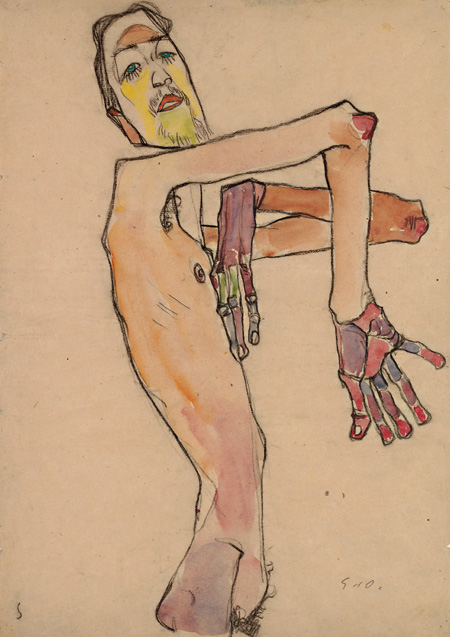Curator Barnaby Wright talks to Betty Wood about the first major exhibition in the UK of the Austrian artist’s work in more than 20 years

As an art student at college, I was fascinated by Egon Schiele’s haunting and often gaunt nudes. His drawings spoke to my own adolescent curiosity about the human form, its inherent beauty and simultaneous strangeness. And they are images that have stuck in my memory.
Their penetrative gaze and unflinching portrayal of otherness sets them apart from the work of Austrian contemporaries, Gustav Klimt and Oskar Kokoschka, and marked them as ‘radical’ in early 20th century Europe. Challenging ideas of public decency – he was imprisoned for two months in 1912 for his ‘pornographic’ works – Schiele set an agenda with his work that went beyond the physical with his psychologically probing drawings, exhibited by The Courtauld Gallery (many of them for the first time in the UK) in Egon Schiele: The Radical Nude.
Exhibition co-curator, Barnaby Wright, explains why it’s the first major exhibit of the artist’s work in two decades and why Schiele’s work was considered so radical.
It’s the first major exhibition of Schiele’s work here in the UK for two decades – why is now the moment for renewed interest?
Barnaby Wright: Schiele is such an important 20th century artist, and the fact that he is so overlooked in this country – combined with the fact there are no major works by Schiele held in public collections in the UK – means that a reappraisal of his work is long overdue. At Courtauld, we have been staging a series of major exhibitions on different themes from the history of drawing, and for us this is a great opportunity to bring that history up to the 20th century with Schiele.
“ is investigating his own body, with a similar sort of penetrating gaze
that he’s investigating other male nudes with”
In what way was Schiele’s depiction of the nude “radical”?
He came out of an art school tradition, having been taught in a fairly staid and conservative way. By that I mean they drew nudes from classical sculptures, and then from very modestly posed life models. And the rules of engagement for those types of academic training were very restrictive. Schiele really wanted to break out of that, to challenge those traditions. He did this by posing his figures in much more provocative, explicit and expressive ways than was allowed for in the academic tradition. He depicted them with line and colour in a way that expressed something that was simply alien to art schools, and indeed to more traditional practices at that time. He wanted to be able to reinvent the genre of the nude, bring it modern relevance with a psychological insight that expressed themes of sexuality and desire in a really new and fresh way.


The Leopold Museum, Vienna
What about the treatment of gender in his work? Is there a marked difference between his portrayal of the female nude, in comparison to his male subjects (including himself)?
Schiele’s interested in both the male and female nude, which certainly wasn’t the case for a lot of artists, and indeed he’s particularly interested in his own nude form. Throughout his career there are self-portrait nudes, so he was investigating his own body with a similar sort of penetrating gaze that he’s investigating other male nudes with.
His female nudes are undoubtedly more sexually and erotically charged. He tends to depict himself more as a sort of tortured, martyr-like figure, but his female nudes cover a huge variety of interests: from explicit and erotic content right through to something that was hard to talk about in those terms – pregnant women. He was interested in the female body as a vessel for new life, as well as having a morbid fascination with the body dying at the same time it’s living. He tried to find ways of expressing bodies in decline and decay as well as in life, simultaneously. It’s a very complex approach he had, and very varied.
This psychological context is important to Schiele’s work in what sense?
It’s absolutely crucial. He’s working in Vienna at a time when all of the conversations in the Viennese cafes were concerned with looking at the human psyche and the human experience in the modern world. This was, of course, the Vienna of Sigmund Freud, and the idea that the body contains within it irrational drives and complex motivations for what we do – and trying to find a way of understanding that – was very urgent in Vienna at this time. I think that Schiele undoubtedly played his part in using the body to explore those themes.
“In a sense there’s no justification, and that means that all we engage with is the naked human body on a blank piece of paper”
How were Schiele’s nudes a departure from, or markedly different from those of his contemporaries’, Klimt and Kokoschka?
Schiele grew out of those avant-garde contemporaries – Klimt and Kokoschka especially – who were pushing the boundaries of representation of the human figures in different ways. I think Schiele’s nudes are starker and more confrontational than Klimt and Kokoschka’s tended to be. Very distinctively, Schiele never set his nude in any sort of context or setting – in a sense there’s no justification for them, and that means that all we engage with as the viewer is the naked human body on a blank piece of paper. All of the subject matter is embedded within the body, without a narrative to wrap it up in. And that is something that, very early on, defined Schiele’s nudes; his gaze was darker, starker and more penetrating than the others’. There’s also less of a concern, as one finds in certain Klimt works, with the body as a decorative element. Schiele expresses something much starker and raw about the human form.
Given his reputation, it’s quite surprising to hear that none of Schiele’s work is held in major public collections here in the UK. Why is that?
I think it’s for obvious historical reasons to do with the two World Wars that German and Austrian art has not found favour that other schools have here in the UK. Some steps have been made to improve collections in those areas, but Schiele’s really missed out. It’s not like there haven’t been opportunities and commercial galleries showing Schiele’s art in London for several decades, but it is one of those great anomalies really…
In the case of Radical Nudes, I think the very clearly focus of the show, and the fact that it is so long overdue in this country, meant that lenders were very generous and there were very few disappointments for us in terms of getting what works we wanted for the show. It’s very important for us that the works we have are of the very highest quality to give the best account of his development. Which they are.
Radical Nudes runs at The Courtauld Gallery from 23 October-18 January. Click for more information




